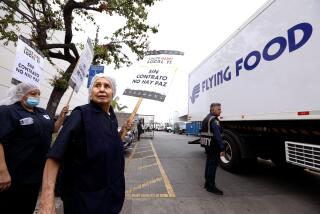Long Treks Added to Travails of the Ill
The searing pain in Ana Margarita Lucero-Garcia’s right side was back. She knew she needed to see the doctor, MTA strike or not.
So the 58-year-old seamstress put on her sneakers and limped out of her one-bedroom apartment.
She shuffled down Rampart Boulevard. Then up 6th Street. Hot and exhausted, she missed the turn on Alvarado Street, arriving at Bonnie Brae Street before realizing her error. The final third of a mile added insult to injury, all of it uphill as the late morning temperature approached the 80s.
Two hours and 15 minutes after she started, Garcia limped into the air-conditioned cool of the Clinica Monsenor Oscar A. Romero waiting room, plopping down onto one of the vinyl seats.
“My God, I’m mad,” she huffed in Spanish, sweat shimmering on her face and neck. She grasped her aching side.
Then, in the few words of English that the Salvadoran immigrant could muster, she summed up feelings echoed by many of Los Angeles’ working poor about the bus drivers strike: “It’s very, very bad, bad, bad. I need, people need, the bus.”
The strike that started Sept. 16 has hurt patients like Garcia terribly, say officials at the nonprofit clinic on South Alvarado. More than half of the patients with appointments--which on Monday numbered 161--were canceling because they couldn’t get rides and were too sick or tired to walk. Garcia said she missed her appointment Wednesday because the trek seemed daunting.
But her pain worsened over the weekend, Garcia said. Other patients who managed to get to the clinic traveled similarly merciless distances on foot. Across from Garcia sat a woman eight months pregnant who had walked eight blocks. Last week, a patient walked nine miles from Westwood, Cramer said.
The clinic already has run through all but three of the taxi vouchers it hands out every month, Executive Director Roland Palencia said Monday. “Most of us have no idea what it means not to have our own means of transportation. It’s really, really hard.”
Even the clinic staff is affected, said chief of operations Ann Cramer, adding that the security guard walked 25 blocks to work.
Garcia said that she pays $350 rent on the tiny apartment she shares with her son and gets a paycheck every two weeks--the last was for $158.85--and can’t afford an increase in bus fare, let alone far more expensive rides being offered by gypsy cabs during the strike. Thankfully, she said through a translator, the 25-cent Dash bus network provides a respite from what otherwise would be a similar hike to and from work.
However, going to the clinic Monday meant walking, Garcia said. Her son, William Stanley, couldn’t drive her. “His car was stolen, around last Christmas,” she said in Spanish.
Fellow patient Asenada Salazar, who sat next to her, got a ride to the clinic but was not immune from the prospect of a long walk. Her son, Jose, said he couldn’t pick her up if the appointment lasted past 11 a.m. If she missed her ride, the 61-year-old diabetic would have to walk about three miles to her house on Thorpe Avenue.
A sympathetic clinic staff made sure she was done by 10:50.
Garcia’s appointment took somewhat longer. She was given prescriptions to relieve high blood pressure and pain.
The doctor told her to get more exercise, to walk more, she said, an irony that seemed lost on her.
She was hungry, but the half-eaten banana she pulled out of her bag had to suffice as lunch. There was no time to stop and eat. It was 2 p.m., and Garcia had to reach the pharmacy at 6th and Union Avenue to fill the prescriptions.
Thankfully, she said, the pharmacy was on her way.
“I get home by 4 p.m.,” she predicted in English, as she shielded her eyes from the hot sun.
More to Read
Sign up for Essential California
The most important California stories and recommendations in your inbox every morning.
You may occasionally receive promotional content from the Los Angeles Times.










